Papers by Nikolaos Theodorakis
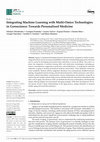
Journal of Personalized Medicine, 2024
Aging is a fundamental biological process characterized by a progressive decline in physiological... more Aging is a fundamental biological process characterized by a progressive decline in physiological functions and an increased susceptibility to diseases. Understanding aging at the molecular level is crucial for developing interventions that could delay or reverse its effects. This review explores the integration of machine learning (ML) with multi-omics technologies-including genomics, transcriptomics, epigenomics, proteomics, and metabolomics-in studying the molecular hallmarks of aging to develop personalized medicine interventions. These hallmarks include genomic instability, telomere attrition, epigenetic alterations, loss of proteostasis, disabled macroautophagy, deregulated nutrient sensing, mitochondrial dysfunction, cellular senescence, stem cell exhaustion, altered intercellular communication, chronic inflammation, and dysbiosis. Using ML to analyze big and complex datasets helps uncover detailed molecular interactions and pathways that play a role in aging. The advances of ML can facilitate the discovery of biomarkers and therapeutic targets, offering insights into personalized anti-aging strategies. With these developments, the future points toward a better understanding of the aging process, aiming ultimately to promote healthy aging and extend life expectancy.
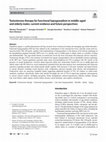
Hormones, 2024
Population aging is a global phenomenon driving research focus toward preventing and managing age... more Population aging is a global phenomenon driving research focus toward preventing and managing age-related disorders. Functional hypogonadism (FH) has been defined as the combination of low testosterone levels, typically serum total testosterone below 300-350 ng/dL, together with manifestations of hypogonadism, in the absence of an intrinsic pathology of the hypothalamic-pituitary-testicular (HPT) axis. It is usually seen in middle-aged or elderly males as a product of aging and multimorbidity. This age-related decline in testosterone levels has been associated with numerous adverse outcomes. Testosterone therapy (TTh) is the mainstay of treatment for organic hypogonadism with an identifiable intrinsic pathology of the HPT axis. Current guidelines generally make weak recommendations for TTh in patients with FH, mostly in the presence of sexual dysfunction. Concerns about long-term safety have historically limited TTh use in middle-aged and elderly males with FH. However, recent randomized controlled trials and meta-analyses have demonstrated safe long-term outcomes regarding prostatic and cardiovascular health, together with decreases in all-cause mortality and improvements in various domains, including sexual function, body composition, physical strength, bone density, and hematopoiesis. Furthermore, there are numerous insightful studies suggesting additional benefits of TTh, for instance in cardio-renalmetabolic conditions. Specifically, future trials should investigate the role of TTh in improving symptoms and prognosis in various clinical contexts, including sarcopenia, frailty, dyslipidemia, arterial hypertension, diabetes mellitus, fracture risk, heart failure, stable angina, chronic kidney disease, mood disorders, and cognitive dysfunction.
Studies in Health Technology and Informatics IOS Press, 2024
This study investigates the forecasting of cardiovascular mortality trends in Greece's elderly po... more This study investigates the forecasting of cardiovascular mortality trends in Greece's elderly population. Utilizing mortality data from 2001 to 2020, we employ two forecasting models: the Autoregressive Integrated Moving Average (ARIMA) and Facebook's Prophet model. Our study evaluates the efficacy of these models in predicting cardiovascular mortality trends over 2020-2030. The ARIMA model showcased predictive accuracy for the general and male population within the 65-79 age group, whereas the Prophet model provided better forecasts for females in the same age bracket. Our findings emphasize the need for adaptive forecasting tools that accommodate demographic-specific characteristics and highlight the role of advanced statistical methods in health policy planning.
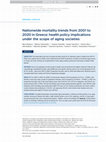
Hellenic Journal of Cardiology, 2024
OBJECTIVE This nationwide study aims to analyze mortality trends for all individual causes in Gre... more OBJECTIVE This nationwide study aims to analyze mortality trends for all individual causes in Greece from 2001 to 2020, with a specific focus on 2020, a year influenced by the COVID-19 pandemic. As Greece is the fastest-aging country in Europe, the study's findings can be generalized to other aging societies, guiding the reevaluation of global health policies. METHODS Data on the population and the number of deaths were retrieved from the Hellenic Statistical Authority. We calculated age-standardized mortality rates (ASMR) and cause-specific mortality rates by sex in three age groups (0-64, 65-79, and 80þ years) from 2001 to 2020. Proportional mortality rates for 2020 were determined. Statistical analysis used generalized linear models with Python Programming Language. RESULTS From 2001 to 2020, the ASMR of cardiovascular diseases (CVD) decreased by 42.7% (p < 0.0001), with declines in most sub-causes, except for hypertensive diseases, which increased by 2.8-fold (p < 0.0001). In 2020, the proportional mortality rates of the three leading causes were 34.9% for CVD, 23.5% for neoplasms, and 9.6% for respiratory diseases (RD). In 2020, CVD were the leading cause of death among individuals aged 80þ years (39.3%), while neoplasms were the leading cause among those aged 0-79 years (37.7%). Among cardiovascular sub-causes, cerebrovascular diseases were predominant in the 80þ year age group (30.3%), while ischemic heart diseases were most prevalent among those aged 0-79 years (up to 60.0%). CONCLUSIONS The global phenomenon of population aging necessitates a reframing of health policies in our aging societies, focusing on diseases with either a high mortality burden, such as CVD, neoplasms, and RD, or those experiencing increasing trends, such as hypertensive diseases.
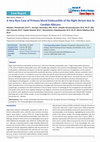
Journal of Clinical and Medical Images, Case Reports, 2024
Right-sided infective endocarditis accounts for 5-10% of all infective endocarditis cases. Fungal... more Right-sided infective endocarditis accounts for 5-10% of all infective endocarditis cases. Fungal endocarditis represents 1-3% of all of infective endocarditis cases, with Candida spp. being the most common microbiological cause. Primary mural endocarditis is defined by the absence of valvular vegetations together with the presence of vegetations on the endocardial free wall that are not associated with myocardial abscesses, cardiac structural abnormalities, devices, prosthetic material, thrombi or tumors. It constitutes a very rare entity and only 63 cases have been published the literature. C. albicans is the microbiological cause in only nine of these cases, none of which involves the right atrium. We report the case of a frail 84-year-old female patient with a pacemaker presenting with fever. In the transthoracic and three-dimensional transesophageal echocardiograms, a mobile mass was found attached on the free wall of the right atrial base. Blood cultures were positive for C. albicans and the modified Duke criteria were fulfilled for a definite diagnosis of infective endocarditis. After evaluation from a heart team the patient was managed with transvenous lead extraction and intravenous high-dose caspofungin, according to the 2023 Guidelines of the European Society of Cardiology for the management of endocarditis. Pacemaker lead cultures were negative leading to the diagnosis of primary mural endocarditis. The patient responded well to treatment with significant clinical and laboratory improvement. Long-term oral fluconazole was initiated after hospital discharge with a close follow-up plan. To our knowledge this is the first case of primary mural endocarditis of the right atrium due to C. albicans.
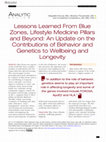
American Journal of Lifestyle Medicine, 2022
Blue Zones are regions of the world that have a higher number of individuals who live longer than... more Blue Zones are regions of the world that have a higher number of individuals who live longer than the expected average. The current paper revisits principles previously identified to be common in Blue Zones and to be contributing to longevity (move naturally, eat wisely, improve resilience to stress, get adequate sleep, keep strong family ties, stimulate strong community support, respect for the planet and having a purpose in life'), compares these to the 6 pillars of Lifestyle Medicine (healthy eating, exercising, avoidance of smoking and other risky substances, stress management, restorative sleep, and forming and maintaining relationships) and reviews new studies investigating the association between behavioral factors and longevity. In addition to the role of behavior, the review also discusses the important role of genetics and emphasizes the importance of conducting further research to understand how behavioral and genetic factors may affect molecular pathways with consequent effects on wellbeing and longevity.
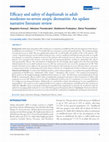
Our Dermatology Online, 2022
Background: Adult atopic dermatitis (AD) is defined as a continuum of childhood AD or the develop... more Background: Adult atopic dermatitis (AD) is defined as a continuum of childhood AD or the development of the disease in adulthood, accounting for 7.7–59.7% of adult AD cases varying in severity and manifestations. The symptomatology of moderate-to-severe adult AD may significantly impact the overall health and quality of life of the patient. The “classic” topical treatments used in mild-to-moderate cases, such as emollients and topical corticosteroids, are usually not adequate to control the symptoms of most of the patients with moderate-to-severe disease. For many years these patients were managed with systemic corticosteroids and immunomodulators, leading to substantial side effects with questionable efficacy. The introduction of dupilumab, the first biologic agent approved by the Food and Drug Administration for use in adult moderate-to-severe AD, has commenced a new era in the management of AD. This narrative literature review addresses the question of how patients with moderate-to-severe AD may achieve a recession or improvement in the overall progression of the disease with the use of dupilumab in both an efficient and safe way. Material and Methods: A search in the PubMed, Embase, and Cochrane databases was conducted using the following combination of MeSH terms: “dupilumab” AND “atopic” (“dermatitis” OR “eczema”). The searches were limited to RCTs written in the English language published before January 25, 2021. The literature used included phase II and III RCTs examining the efficacy and/or safety of dupilumab compared to placebo or other treatments in adults with moderate-to-severe AD. Moderate-to-severe AD was defined by an IGA score of 3 (moderate) or 4 (severe) and EASI 16 or higher at screening and baseline. Additionally, we searched the website clinicaltrials.gov for any unpublished or ongoing RCTs. The search was done independently by two authors in all databases and followed by the exclusion of duplicates. Results: Upon reviewing all randomized controlled trials, dupilumab was found to be an effective and safe option for managing adult moderate-to-severe AD with long-term therapeutic effects. Conclusion: The best results for maintaining long-term disease recession were achieved with the combination of dupilumab and topical corticosteroids.








Uploads
Papers by Nikolaos Theodorakis